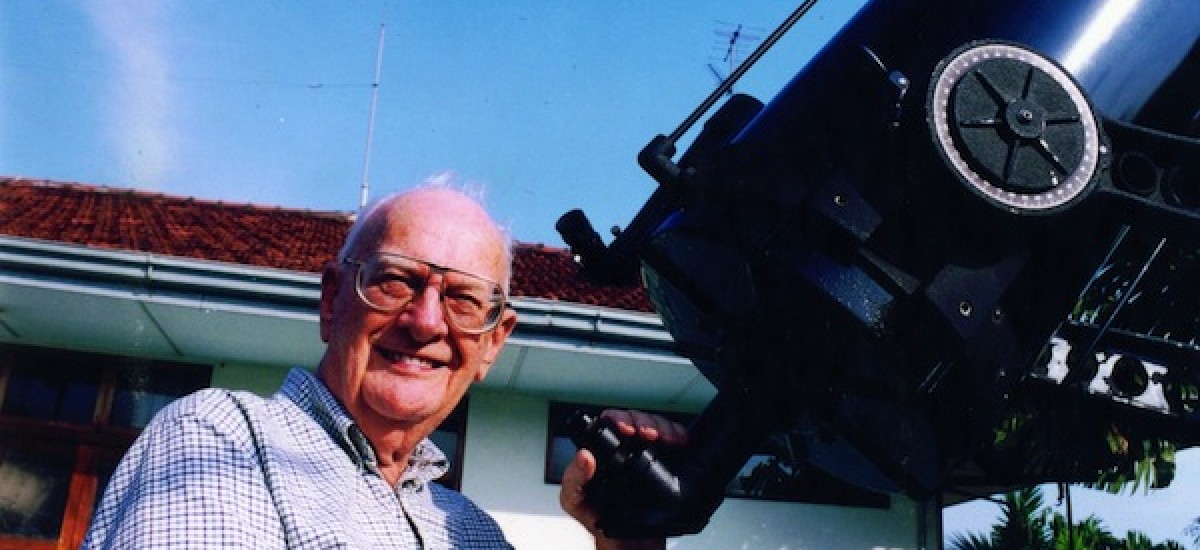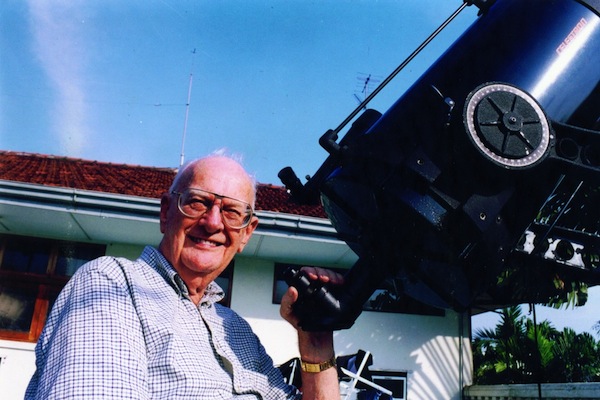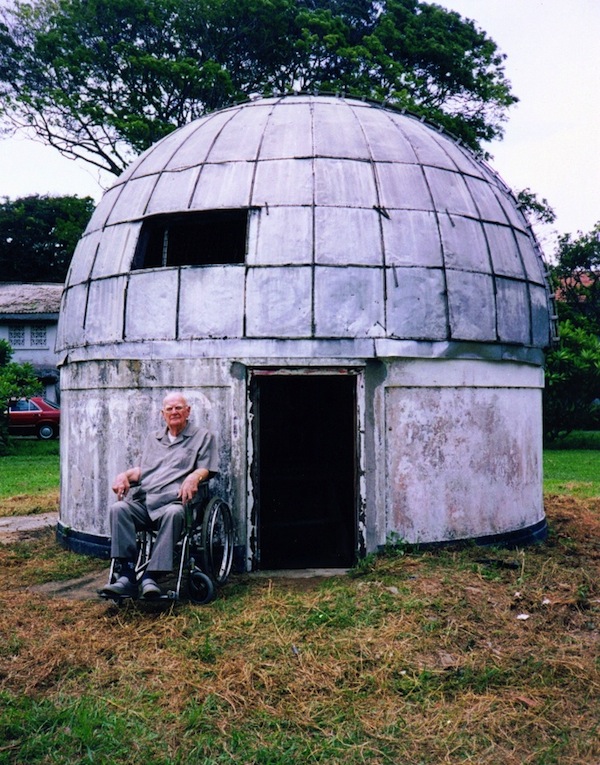Sir Arthur Clarke with his Celestron 14-inch telescope – photo by Rohan de Silva, circa 2001
Every newshound must survive a ‘lean news’ day. Most know what to do when that happens: sniff around, or dig deeper.
But like our canine friends, newshounds too occasionally bark up the wrong tree or dig in vain. Pressures of feeding the 24/7 news cycle can be immense, especially when the war has ended and no cricket matches or ‘grease devil’ performances are on.
On 27 September 2011, News First ran a story titled ‘Arthur C Clarke’s telescope sold by an assistant’. It said a ‘telescope owned by the late Sir Arthur C Clarke has been sold by an assistant for one million rupees’ through a newspaper advertisement. The buyer’s identity was not disclosed.
The story added: “Astrologists (sic) say the telescope belonging to the late science visionary is a valuable artefact not only to Sri Lanka but to the entire world. They point out that it is the government’s responsibility to safeguard such an item.
The astronomer/astrologer mix-up is common in Sri Lanka. The Sinhala news story, which the same website published a few hours earlier, got the label right. Both quoted the same atmospheric physicist: Dr Chandana Jayaratne of the University of Colombo.
Dr Jayaratne was reported as saying that “such belongings of Arthur C Clarke must be restored and kept at a public location so that future generations can also learn about the history behind it.”
Lofty words, indeed. But neither the reporter nor the physicist seemed to be interested in going beyond rumours and rhetoric. The facts are not that hard to come by, if only they researched the story a bit further.
Celestial Knight
The telescope concerned is a Celestron 14 reflector that Sir Arthur imported from its US-based manufacturer in the 1980s. It was among many items that Sir Arthur bequeathed on his adopted Sri Lankan family, the Ekanayakes, and the Dr Arthur C Clarke Trust, a legal entity registered while he was still living.
Sir Arthur’s Last Will went through the usual testamentary proceedings in the Sri Lankan judicial system. No objections were raised by anyone. The beneficiaries are now free to retain, modify or sell what they received as they deem fit. Despite the public figure involved, it is entirely a private matter.
Following the news story, I checked with the Sir Arthur’s trusted business partner for half a century, Hector Ekanayake. Yes, the telescope was recently advertised in the classifieds for sale. No, it hasn’t found a buyer yet. The ‘sale price’ of one million rupees (USD 9,070 at current exchange rates) probably stemmed from the reporter’s imagination.
Legalities and shoddy journalism apart, is there any museum value in this telescope? Let’s investigate.
The Celestron-14 was the last – and most sophisticated – in a series of telescopes that Sir Arthur owned and used for night sky observations. As a young farm lad growing up in the 1920s, he home-built his own first telescope in Minehead, rural England. Over the next few decades, he bought a succession of telescopes intended for the serious amateur astronomer.
Sir Arthur earned a living as a writer of science fiction and science fact, who only dabbled in amateur astronomy and undersea diving as serious hobbies. When he settled down in Ceylon in 1956, he realised that most of the northern and southern skies were visible from this almost-Equatorial location. But he also found out that observations were not easy since “half the year we can’t observe due to cloud cover”.
Undaunted, he became an opportunistic night sky watcher, catching a glimpse of the heavens when weather and schedule permitted. The astronomy ‘bug’ soon spread and the Ceylon Astronomical Association (CAA) was established in June 1959 to promote organised amateur astronomy. Arthur C Clarke became its founder president.
So the Celestron-14 had many antecedents. Upon its arrival in Sri Lanka, it was located on the balcony of his Cinnamon Gardens home, and used for occasional star gazing. In his latter years, when Sir Arthur was wheel-chaired by Post Polio Syndrome and direct observations became difficult, he even coupled a television camera to the telescope. “I can now ‘hover’ over the Moon from the comfort of my living room!” he told his friends at the time.
For a few years, this Celestron 14-inch (36cm) was the largest telescope in Sri Lanka. Then in 1994, the Japanese government donated a GOTO 18-inch (45cm) Cassegrain telescope to the government as part of bilateral aid.
Teenaged Arthur Clarke observes night sky using home-made telescope in Minehead, UK – circa 1933 – Photo owned by Arthur C Clarke Estate.
Misplaced gift
Sir Arthur wasn’t too happy when bureaucrats in the Ministry of Science and Technology decided to locate the Japanese telescope at the government institute in Moratuwa named after him. Other amateur and professional astronomers shared his concern because of urban light pollution, air pollution and weather factors.
Simon Tulloch, a British astronomer living in Sri Lanka at the time, carried out an independent site survey and found that two locations in the Kandy district — Kirimetiyakanda and Karagahatenna — were far superior to Moratuwa. But the babus ignored Tulloch’s recommendation that the Japanese-gifted telescope be relocated to one of these locations after studying their local weather for one year.
Fifteen years on, the GOTO telescope remains firmly rooted in Moratuwa — another reminder how expedience rules over evidence-based decision making in Sri Lanka. What serious observation or research this expensive instrument can make in suburban Colombo?
“It has not produced a single paper published in a refereed Journal during the 15 years of its operation”, says Dr Kavan Ratnatunga, an astrophysicist who was motivated by Sir Arthur to study astronomy.
Ratnatunga, now retired to Sri Lanka after an international research career, finds it ‘amusing’ that anyone should recommend Sir Arthur’s modern 14-inch Celestron be protected in a museum ‘for posterity’.
He adds: “Ironically, it’s the younger and larger 18-inch telescope gifted by Japan, and now at the institution that bears Arthur’s name, which has practically become a museum piece — being shown off to visiting school children!”
Ratnatunga’s exasperation was shared by Sir Arthur when, during his last decade, he heard how schools were being asked to visit the telescope during the working hours of 9 to 5!
In contrast, Sir Arthur’s privately-owned Celestron-14 was used for real observations by its owner and occasionally by his amateur astronomer friends. To them, astronomy was a passion, not a day-time job!
It also earned honourable mentions in Sir Arthur’s writing. For example, in an Op-Ed titled ‘Killer Comets Are Out There. Now What?’, he wrote in the New York Times on 14 August 1994:
“Soon after the last fragments of the comet Shoemaker-Levy 9 crashed into Jupiter last month, the monsoon skies above my home in Colombo cleared momentarily and I hurried to set up my 14-inch Celestron telescope. I didn’t really expect to see anything, so I could hardly believe my eyes when I clearly observed a line of dark bruises spread out across the planet’s southern hemisphere.
“Some imaginative souls suggested that the comet might have a catastrophic impact on Jupiter, but its effect will be largely cosmetic. And it will certainly have no effect on Earth, despite the inevitable alarmist warnings by religious fanatics. But the spectacular collision between the newly discovered comet with the solar system’s largest planet has brought sudden new attention to a genuine threat: the chance that a rogue comet or asteroid could strike Earth, with possibly devastating consequences.”
That was classic Clarke, no doubt, but not exactly frontier research. In fact, Celestron-14 always remained a toy, albeit an expensive one, of that boy who never grew up…
Sir Arthur Clarke at the Colombo University observatory where the Molesworth telescope was housed – 2003 photo by Rohan de Silva
Vandalised History
So is there any historical significance in this commercially-made telescope used for hobby astronomy by a celebrity owner for a couple of decades?
We can debate it, for sure. But current physicists at the University of Colombo, of all people, have no moral right to talk about ‘protecting’ any telescope. Not after they completely and miserably failed to look after Sri Lanka’s most historic telescope that was entrusted to their care.
That was the telescope used by Percy Braybrooke Molesworth (1867 – 1908), who lived and worked in Trincomalee, and regarded as one of the world’s leading astronomers at the beginning of the last century.
By profession, Molesworth was a major in corps of Royal Engineers, an Englishman by birth who — like Arthur C Clarke — spent the better part of his life in Ceylon. From his private observatory in Trincomalee, Molesworth observed the night sky and photographed celestial bodies, the results of which were shared with leading astronomical groups in the west. Armed only with a basic telescope, a sharp eye and good drawing skills, he made significant contributions to advancing our knowledge of the heavens at the time.
For example, in February 1901, Molesworth was the first observer in the world to notice the beginning of the great South Tropical Zone Disturbance on Jupiter that was to last until 1939. This discovery made an important contribution in understanding Jovian atmospheric currents.
Decades later in 1973, the International Astronomical Union (IAU) named one of the largest Martian craters in Molesworth’s honour. He is the first Ceylonese on Mars, and one of the very few Lankans to leave their name in the sky…
But his legacy is both forgotten and neglected in Sri Lanka. After his premature death in 1908 aged 41, his custom-made 12.5-inch (32cm) Calver reflector telescope went into disuse. Some years later, it found its way to the University of Colombo, which housed it in a small dome on the grounds adjoining Reid Avenue.
Astrophysicist Ratnatunga, who studied at the University of Colombo in the early 1970s, recalls repairing the Molesworth’s telescope with science faculty lecturer late Dr V K Samaranayake. Afterwards, they used it for night sky observations.
That ended in 1988, when vandals looted the telescope for its metallic value. The culprits were never caught; with a youth insurgency in full swing, the university authorities and police had more pressing concerns.
I covered that incident as a young science journalist, and have been interested in it since. As I wrote in a death centennial tribute to Percy Molesworth in 2008, the telescope never recovered from that looting, and the University has shown little enthusiasm in preserving it.
In 2003, Sir Arthur wrote to the then Vice Chancellor in 2003 drawing his attention to “what is possibly the oldest piece of scientific equipment in their inventory”. The letters were not even acknowledged.
So when a Colombo University physicist calls for protecting Arthur Clarke’s hobby telescope, we have to point out his own institution’s appalling track record in protecting what was entrusted to them!
What about the Arthur Clarke Institute for Modern Technologies (ACCIMT)? Founded by the Jayewardene government in the mid 1980s with noble objectives and international goodwill, it never really took off.
When assessed using universally accepted measures of scientific productivity -– such as research publications in refereed international journals, peer citations and patents for innovation — it shows a dismally poor track record. It is today a disgrace to the very man it was meant to honour.
For 25 years, the Arthur Clarke institute took cover behind its famous patron to avoid adequate public and media scrutiny. Many Lankans mistakenly believed that Sir Arthur Clarke was involved in its management and research. In fact, he distanced himself from it during the last decade of his life.
Unlike Sir Arthur’s private office in Colombo (now closed), the Clarke Institute is a government body being sustained by taxpayers. My questions about the Clarke Institute’s poor performance, posed in a media article published in April 2009, have gone unanswered for over two years.
That, to me, is the real story. For any journalist dogged enough to follow these leads, there is a matter of public interest in Moratuwa — one about missed opportunities, misplaced priorities and continuing waste of Lankan (and Japanese) tax payer money.
Sadly, a nation and its news media blinded by hype keep missing it!
Note: All the information in this essay is only a Google search or phone call away — well within the reach of any serious journalist or researcher.
Science writer Nalaka Gunawardene worked for Sir Arthur Clarke’s personal office in Colombo (1987-2008), which was totally separate from the government’s Arthur Clarke Institute. He writs a weekly science and media column in Ravaya newspaper, and blogs at: http://nalakagunawardene.com




